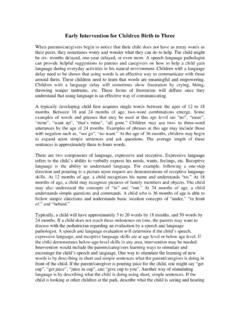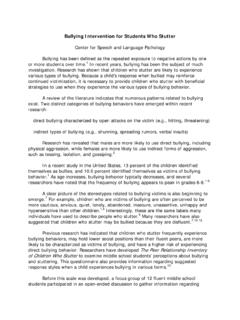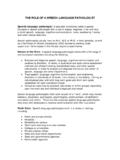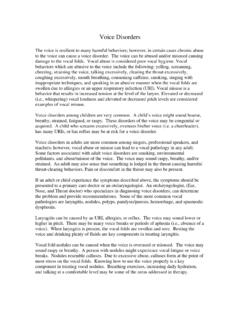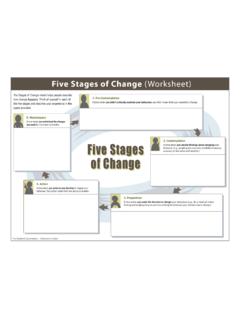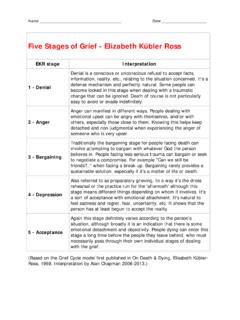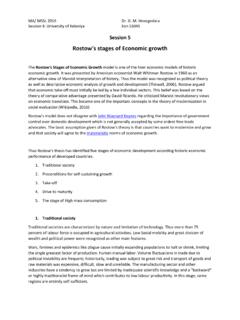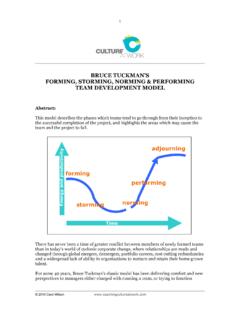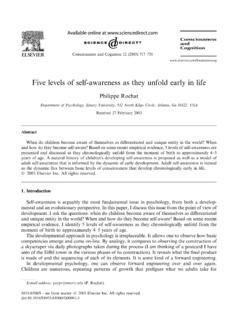Transcription of Early Morphological Development - speechtherapyct.com
1 Early Morphological Development Morphology is the aspect of language concerned with the rules governing change in word meaning. Morphological Development is analyzed by computing a child's Mean Length of Utterance (MLU). Usually, a sample of 50 to 100 utterances is analyzed to draw conclusions about the child's overall production. Each word a child produces is broken down into morphemes. A morpheme is the smallest, indivisible unit of meaning. For example, the word walk is one morpheme, while walked is two morphemes: Walk . carries its own meaning and ed signifies past tense. Young children often combine words to convey one meaning or idea. Consequently, words such as gonna count as one morpheme. As adults, we understand that gonna really consists of both going.
2 And to , each having meaning. After counting the morphemes for each of the child's utterances, they are totaled and divided by the total number of utterances. The formula is as follows: MLU= Total number of morphemes Total number of utterances A child's MLU typically corresponds closely to their age. Roger Brown described five stages of language Development based on MLU. The following table outlines typical MLU Development : Stage MLU Approximate Age (In Months). I 12-26. II 27-30. III 31-34. IV 35-40. V 41-46. V+ + 47+. Source: Compiled form Brown (1973). Morphological acquisition is best outlined by Brown's Fourteen Grammatical Morphemes. The chart below details at what age each morpheme typically emerges. Morpheme Example Age of Mastery*.
3 (In Months). Present Progressive ing Mommy driving 19-28. In Ball in cup 27-30. On Doggie on sofa 27-33. Regular plural -s Kitties eat my ice cream. 27-33. Forms: /s/, /z/ and /iz/. Cats, Dogs, Classes, Wishes Irregular past Came, fell, broke, sat, went 25-46. Possessive s Mommy's balloon broke 26-40. Forms: /s/, /s/ and /iz/ as in regular plural Uncontractible copula He is. 28-46. (Verb to be as main verb) (Response to Who is sick?). Articles I see a kitty. 28-46. Regular past -ed Mommy pulled the wagon 26-48. Forms: /d/, /t/, /Id/. Pulled, Walked, Glided Regular third person -s Kathy hits 28-50. Forms: /s/, /z/, and /iz/. Irregular third person Does, has 28-50. Uncontractible auxiliary He is. 29-48. (Response to Who is wearing your hat?)
4 Contractible copula Man's big 29-49. Man is big Contractible auxiliary Daddy's eating 30-50. Daddy is eating *Used correctly 90% of the time in obligatory contexts. Adapted from Bellugi & Brown (1964); R. Brown (1973); and J. Miller (1981). Sentence forms begin to develop as Early as 12 months of age. Sentences can take on several different forms, including declarative, negative, interrogative, embedded and conjoined. The following table details the Development of each: Stage Age (In Declarative Negative Interrogative Embedding Conjoining Months). Early I 12-22 Agent + Single word-no, Yes/no Serial (MLU: 1- Action; all gone, gone questions naming ) asked with without Action+ rising and object intonation on a single word.
5 What and where Late I 22-26 Subj. + No and Not used What doing? Prepositions And (MLU: Verb + Obj. interchangeably in and on appears 2) appear Early II 27-28 Subj. + Where going? Gonna, (MLU: 2- Copula + wanna, ) Compl. gotta etc. appear Late II 28-30 Basic No, not, don't, Earliest ( subject- and can't used inversion ) verb-object interchangeably; appears with used by negative copula in most element placed what/where +. children between subject copula +subj and predicate. Early III 31-32 Subj. + aux. Auxiliary But, so, or ( + verb + verbs do, can and if ) objet. and will begin appear Appears; to appear n auxiliary questions;. verb forms inversion of can, do subject and have will aux. verbs and be appears in appear yes/no questions Late III 33-34 Auxiliary Won't appears Aux.
6 Verbs ( verb do, can, and 3) appears will appear in with copula questions in subj. +. aux. +. copula + X. Stage Age (In Declarative Negative Interrogative Embedding Conjoining Months). Early IV 35-37 Negative Inversion of Object noun- Clausal (MLU:3- appears auxiliary verb phrase conjoining ) with and subject in complements with and auxiliary wh- questions appear with verbs appears, verbs such as think, because guess and show; appears embedded wh- questions Late IV 38-40 Double Adds isn't, Inversion of Infinitive phrases (MLU: 3- auxiliary aren't copula and appear at the verbs doesn't subject in ends of sentences appear in and didn't yes/no subj. + aux. questions;. + aux.+ adds when verb + X and how V 41-46 Indirect Adds Some adult Relative Clauses Clausal ( object wasn't, like tag appear Conjoining ) appears in wouldn't, questions with if subj.)
7 + aux. couldn't, appear appears;. + verb + and three clause ind. obj. + shouldn't declaratives obj. appear Post V 47+ Adds Questions Gerunds appear. Clausal ( +) indefinite other that Relative clauses conjoining forms one-word attached to with nobody, no why subject, because one, none questions embedding appears and appear. and conjoining with when, nothing. appear within the but and so Has same sentence beyond an difficulty above an MLU of MLU of with double negatives. By age five, a child is able to use most of the major variations of the English language. The order that these varieties are acquired indicates a pattern of cognitive, social and learning growth. Language continues to develop into Early adulthood to include more sophisticated usage.
8 For more on language Development , consult the following resources: Adrian , A. (Ed.). (1995). Lingistics: an introduction to language and communication. 4th ed. Cambridge, MA: MIT Press. Owens, R. (2001). Language Development : an introduction. 5th ed. Needham Heights, MA: Allyn and Bacon. Center for Speech and Language Pathology
